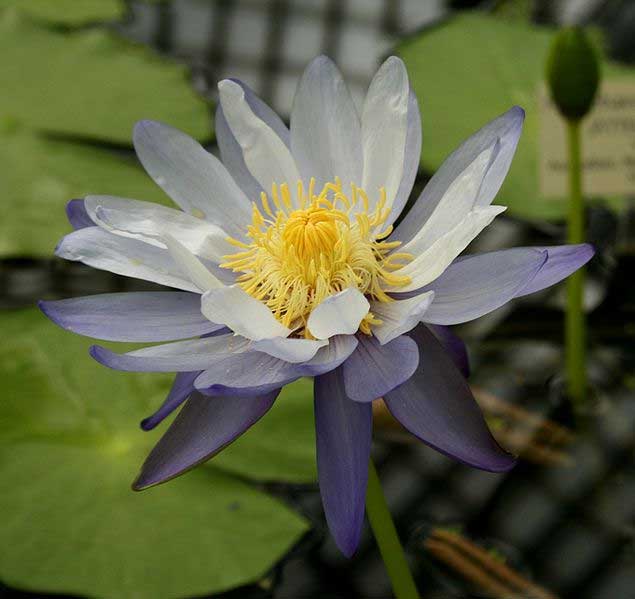
Nymphaea gigantea (*)
Classification System: APG IV
Superregnum: Eukaryota
Regnum: Plantae
Cladus: Angiosperms
Classis: Unassigned
Ordo: Nymphaeales
Familia: Nymphaeaceae
Genus: Nymphaea
Subgenus: N. subg. Anecphya
Species: Nymphaea gigantea
Name
Nymphaea gigantea Hook. (1852)
Synonyms
Castalia gigantea (Hook.) Britten, J. Bot. 26:9. 1888
Leuconymphaea gigantea (Hook.) Kuntze, Revis. gen. pl. 1:11. 1891
Nymphaea gigantea f. alba Bentham & Müller, 1852
Nymphaea gigantea f. candida Domin, (1926) Beitrage zur Flora und Pflanzengeographie Australiens. Bibliotheca Botanica 22(89): 658.
Nymphaea gigantea f. hudsonii (Anon.) K.C.Landon, (1978) Phytologia 40: 439.
Nymphaea gigantea var. alba (Bentham & Müller) K.C.Landon Phytologia 40: 441. 1978. nom. inval.
Nymphaea gigantea var. hudsoniana F. Henkel et al., Das Buch der Nymphaeaceen oder Seerosengewächse 65. 1907.
Nymphaea gigantea var. hudsonii Anon., Gard. World 20:756. 1903.
Nymphaea gigantea var. media F. Henkel et al., Das Buch der Nymphaeaceen oder Seerosengewächse 65. 1907
Nymphaea gigantea var. neorosea K.C.Landon, Phytologia 40: 441. 1978.
Nymphaea gigantea var. normalis Domin, Beitrage zur Flora und Pflanzengeographie Australiens. Bibliotheca Botanica 22(89): 658. 1926 nom. inval.
Victoria fitzroyana Loud.
References
for references see:zipcodezoo
Australian Plant Name Index (APNI)
Vernacular names
Deutsch: Riesenseerose, Australische Seerose
English: Australian water-lily
Nymphaea gigantea is a species of aquatic perennial herbaceous plant native to Australia and New Guinea.[2][3] N. gigantea is a tropical and sub-tropical species that establishes tubers in the muddy bottoms of still waters.
Petals can be seen to be a light purple-blue when they first blossom. As they become mature plants they become a light blue, or can even be white.[4]Due to its blue-white color, it is also known as “Blue Cloud", and typically flowers between the months June and July. [5]
Taxonomy
The species was brought to England by Frederick Strange, where it received notices in newspapers and began to be cultivated by nurseries.[6] William Jackson Hooker gave a description of the new species as Nymphaea gigantea in The Botanical Magazine, with a illustration detailing the flower and sections by Walter Hood Fitch.[1][6]
Description
The leaves of the N. gigantea are round and can grow out to 75 cm across and are sinuate and dentate. In botany, this means that their edges are toothed with pointed teeth, about 0.5 cm long. The apex of the lobes are rounded, however, the N. gigantea develop points in the space between the lobes from the rest of the leaf. The flowers are emergent, standing 50 cm above the water, and growing to about 25 cm across. The leaves of N. gigantea lie on the water and are generally thick giving them a leathery feeling but are also brittle. The stigma is very dense with papillae, covering the dorsal surface of the carpels. [7][8]
Distribution and Habitat
The seeds of N. gigantea are eaten by the Australians. In Australia, the tubers are collected and roasted by Aboriginal women. The buds and flower stalks are collected and eaten as well. [9]N. gigantea was first introduced in England in1852. Three years later in 1855, Van Houtte fruited the species. Since 1865, N. gigantea has been observed to flower during the summer months in water because that is the optimum condition for the tubers to germinate.[10]
References
Hooker, William Jackson; Fitch, Walter Hood (1852). "Tab 4646 Phrynium Sanguineum". Curtis's Botanical Magazine. 78: 4647.
Conard, Henry S. (1991). The waterlilies : a monograph of the genus Nymphaea ([Faks.-Ausg. d. Erstausg. von 1905] ed.). Suffolk, England: Lark. ISBN 0948697172.
Coiro, Mario; Barone Lumaga; Maria Rosaria (22 May 2013). "Aperture evolution in Nymphaeaceae: insights from a micromorphological and ultrastructural investigation". Grana. 52 (3): 192–201. doi:10.1080/00173134.2013.769626.
"Nymphaea gigantea". The Royal Botanic Gardens & Domain Trust. Archived from the original on 2013-06-01. Retrieved 2013-06-21.
"Nymphaea gigantea 'Blue Cloud'". plantexplorer.longwoodgardens.org. Retrieved 2019-12-12.
Whittell, H. M. (1947). "Frederick Strange". The Australian Zoologist. 11: 96–114.
"Nymphaea gigantea - Large Blue Water Lily". www.flowersofindia.net. Retrieved 2019-12-12.
Arlington Water Lily Gardens, water lily specialists, growers of water lilies and aquatic plants. Arlington, New Jersey: Arlington Water Lily Gardens. 1928. doi:10.5962/bhl.title.139866.
Prance, Sir Ghillean (2012-10-12). Prance, Sir Ghillean; Nesbitt, Mark (eds.). The Cultural History of Plants. doi:10.4324/9780203020906. ISBN 9780203020906.
Conard, Henry Shoemaker (1905). The waterlilies: a monograph of the genus Nymphaea. [Washington]: Carnegie Institution of Washington. doi:10.5962/bhl.title.51290.
Retrieved from "http://en.wikipedia.org/"
All text is available under the terms of the GNU Free Documentation License

